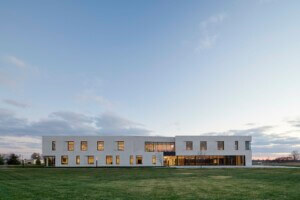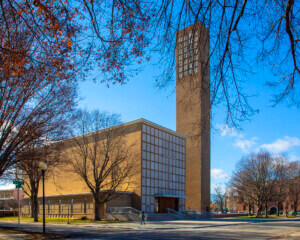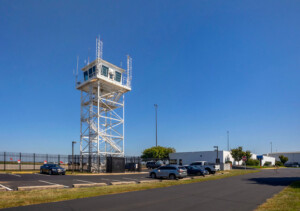The Columbus we know best is not in Indiana. But Kogonada’s eponymous feature film shifts our attention to a lesser-known Midwestern city in Indiana, one with a progressive reputation and a travel destination for architecture aficionados. Columbus introduces this exceptional city with its rich modernist heritage to a larger audience. Atypical in its blend of a documentary style and narrative, it was screened at Sundance to surprising critical success and presented at the prestigious BAM Cinefest.
The debut film marks Kogonada’s transition from videographer to filmmaker. The impeccable framing and characteristic lingering shots reveal Kogonada’s deep involvement with the work of director Jasujiro Ozu, the subject of his unfinished dissertation. The long slow takes that heighten the dramatic presence of the characters and a meticulous attention to place and historical context suggest the influence Neorealist auteurs. With this cinematic foundation, Kogonada goes on to develop a hybrid approach to filmmaking. The result of his efforts is an indelible portrait of place.
Indeed, we leave the theatre with a feeling we have been there, led through a small selection of modernist buildings on one of the official architectural tours. Unlike most cities, with their abandoned city centers, spotty pockets of skyscrapers, and suburban sprawl, Columbus has an astonishing number of ground-hugging public buildings and businesses, and the film explores the impact this architecture has on the city and its inhabitants. But Kogonada has a more ambitious and complex project in mind.
The film is driven by a spare, somewhat improbable narrative. Jin, played by John Cho, is a translator stranded in the city while his semi-estranged father, a famous architectural historian, is hospitalized for a coma following a stroke. We witness his encounter with Casey, played by the highly lauded Haley Lu Richardson, a tour guide who has relinquished her studies to take care of her heroine-addicted mother. Casey leads Jin through the city, introducing him to her favorite buildings. She, an ardent supporter of her town’s rich architectural heritage, tries to convey how she is personally affected by the buildings. She describes the moment she first “saw” them and what they meant to her.
Casey claims most people “don’t give a shit about architecture,” but Deborah Berke’s First Financial Bank speaks to her in a profound way. Are we to suppose that it offers a sense of order in her otherwise chaotic life? Can we then understand how modern architecture engenders that sense of stability in a complex world? Casey explains that Berke deploys a basic asymmetry, and then works to create “a delicate balance” among the parts. They discuss the merits of James Polshek’s claim that architecture is “responsible for healing,” as they stand before his bridge leading to the hospital. Two Saarinen churches elicit questions about religion and modern architecture. These and other issues constitute the conversations between the two characters as they meet and move through the city exploring the buildings. We observe them observing, we see what they see, and are invited to ponder the questions with them.
To clarify and enrich our understanding of the modernist architecture, the camera sets up a kind of compare-and-contrast as it moves from the public buildings to the interiors of Casey’s modest, low-lit home where she resides with her mother. Close cropped shots of quotidian details conjure the claustrophobic, yet cozy environment in striking contrast with those of the lavish Edwardian Irwin Inn where Jin resides. “Not very modernist,” he claims, stating the obvious, yet at the time of the final renovation in 1910, it was praised for its modern use of electricity, telephone, intercom, and even a hydraulic elevator. We wander through lavish rooms pausing over the British oak furniture, silk lined walls, tiles from France and Wales, and explore the extravagant gardens in long takes as leaves on a single tree flutter in a gentle breeze.
These images provide the backdrop for an asexual yet emotionally charged and intensely intimate friendship between the two as they recount their lives and struggles. The terse dialogue is punctuated by long silences as we await their self-realizations. But somehow, despite the careful structure and fine acting, the storyline of their relationship ultimately fails to move us. The architecture of the plot is revealed in the way that structural systems are deliberately exposed in some buildings. Perhaps this parallel was Kogonada’s intention? Ultimately, the contrivance of the plot lessens the transformative impact of the story.
On the contrary, what moves us most is Elisha Christian’s cinematography. Each shot seems deliberate, designed to reveal the way buildings work. One watches indistinguishable figures moving through passageways in the distance while the actors converse in the foreground. A skateboarder surprises us as he glides across the screen only to disappear into the shadows through a hallway in the background. Perhaps the most powerful moments occur when Casey discovers that her mother has resumed lying to her. We see Casey, hidden in the dark, telephoning one of the cleaners working through the night, her red shirt punctuating the brightly lit office. This scene calls to mind Krzysztof Wodiczko’s projection piece at the Venice Biennale in 2009, in which he created a Venetian arcade along the interior walls of the exhibition space. Between each column was a scrim with what appeared to be shadows of the piazza beyond, rather like a camera obscura. Wodiczko conjured life in the streets, and we hear barely audible fragments of conversations coming from the invisible piazza.
In contrast, what we see in Columbus is a single, solitary figure moving through stark, pristine spaces. The only sounds are those of the tete-a-tetes of our characters. What pervades this film is the silence of Edward Hopper’s paintings and a profound loneliness mediated by the promise of modern architecture.










